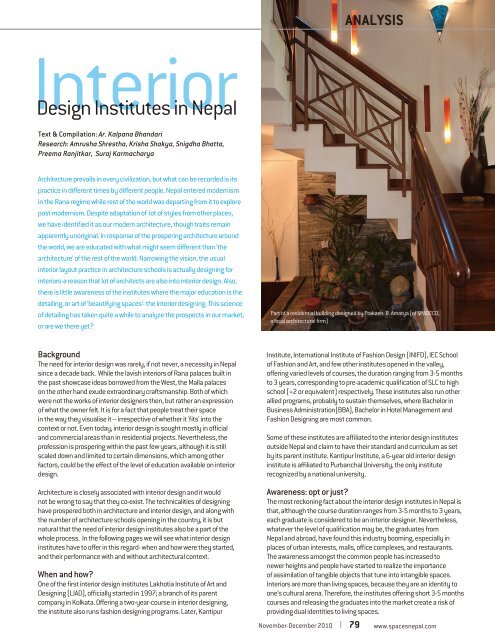6. Nov-Dec 2010
Create successful ePaper yourself
Turn your PDF publications into a flip-book with our unique Google optimized e-Paper software.
Interior<br />
Design Institutes in Nepal<br />
Text & Compilation: Ar. Kalpana Bhandari<br />
Research: Amrusha Shrestha, Krisha Shakya, Snigdha Bhatta,<br />
Preema Ranjitkar, Suraj Karmacharya<br />
ANALYSIS<br />
Architecture prevails in every civilization, but what can be recorded is its<br />
practice in different times by different people. Nepal entered modernism<br />
in the Rana regime while rest of the world was departing from it to explore<br />
post modernism. Despite adaptation of lot of styles from other places,<br />
we have identified it as our modern architecture, though traits remain<br />
apparently unoriginal. In response of the prospering architecture around<br />
the world, we are educated with what might seem different than ‘the<br />
architecture’ of the rest of the world. Narrowing the vision, the usual<br />
interior layout practice in architecture schools is actually designing for<br />
interiors-a reason that lot of architects are also into interior design. Also,<br />
there is little awareness of the institutes where the major education is the<br />
detailing, or art of ‘beautifying spaces’- the interior designing. This science<br />
of detailing has taken quite a while to analyze the prospects in our market,<br />
or are we there yet?<br />
Part of a residential building designed by Prakash. B. Amatya (of SPADECO,<br />
a local architectural firm)<br />
Background<br />
The need for interior design was rarely, if not never, a necessity in Nepal<br />
since a decade back. While the lavish interiors of Rana palaces built in<br />
the past showcase ideas borrowed from the West, the Malla palaces<br />
on the other hand exude extraordinary craftsmanship. Both of which<br />
were not the works of interior designers then, but rather an expression<br />
of what the owner felt. It is for a fact that people treat their space<br />
in the way they visualise it – irrespective of whether it 'fits' into the<br />
context or not. Even today, interior design is sought mostly in official<br />
and commercial areas than in residential projects. Nevertheless, the<br />
profession is prospering within the past few years, although it is still<br />
scaled down and limited to certain dimensions, which among other<br />
factors, could be the effect of the level of education available on interior<br />
design.<br />
Architecture is closely associated with interior design and it would<br />
not be wrong to say that they co-exist. The technicalities of designing<br />
have prospered both in architecture and interior design, and along with<br />
the number of architecture schools opening in the country, it is but<br />
natural that the need of interior design institutes also be a part of the<br />
whole process. In the following pages we will see what interior design<br />
institutes have to offer in this regard- when and how were they started,<br />
and their performance with and without architectural context.<br />
When and how?<br />
One of the first interior design institutes Lakhotia Institute of Art and<br />
Designing (LIAD), officially started in 1997; a branch of its parent<br />
company in Kolkata. Offering a two-year-course in interior designing,<br />
the institute also runs fashion designing programs. Later, Kantipur<br />
Institute, International Institute of Fashion Design (INIFD), IEC School<br />
of Fashion and Art, and few other institutes opened in the valley,<br />
offering varied levels of courses, the duration ranging from 3-5 months<br />
to 3 years, corresponding to pre-academic qualification of SLC to high<br />
school (+2 or equivalent) respectively. These institutes also run other<br />
allied programs, probably to sustain themselves, where Bachelor in<br />
Business Administration(BBA), Bachelor in Hotel Management and<br />
Fashion Designing are most common.<br />
Some of these institutes are affiliated to the interior design institutes<br />
outside Nepal and claim to have their standard and curriculum as set<br />
by its parent institute. Kantipur Institute, a 6-year old interior design<br />
institute is affiliated to Purbanchal University, the only institute<br />
recognized by a national university.<br />
Awareness: opt or just?<br />
The most reckoning fact about the interior design institutes in Nepal is<br />
that, although the course duration ranges from 3-5 months to 3 years,<br />
each graduate is considered to be an interior designer. Nevertheless,<br />
whatever the level of qualification may be, the graduates from<br />
Nepal and abroad, have found this industry booming, especially in<br />
places of urban interests, malls, office complexes, and restaurants.<br />
The awareness amongst the common people has increased to<br />
newer heights and people have started to realize the importance<br />
of assimilation of tangible objects that tune into intangible spaces.<br />
Interiors are more than living spaces, because they are an identity to<br />
one’s cultural arena. Therefore, the institutes offering short 3-5 months<br />
courses and releasing the graduates into the market create a risk of<br />
providing dual identities to living spaces.<br />
79 www.spacesnepal.com<br />
<strong>Nov</strong>ember-<strong>Dec</strong>ember <strong>2010</strong>

















